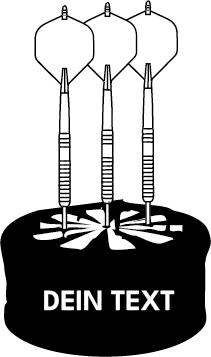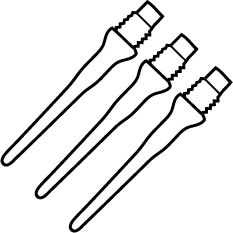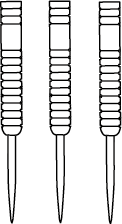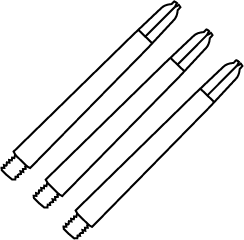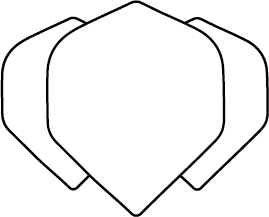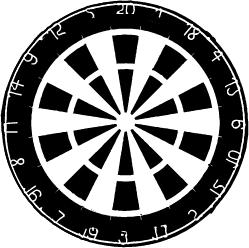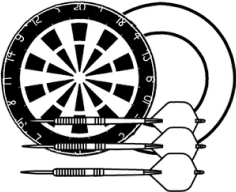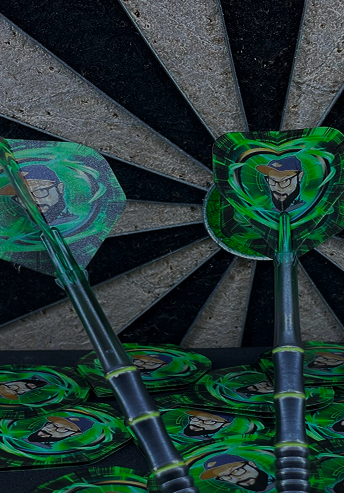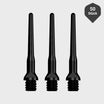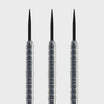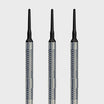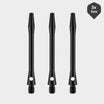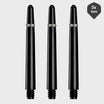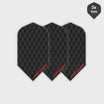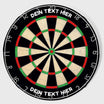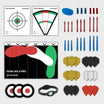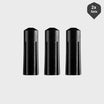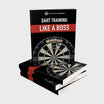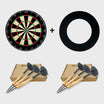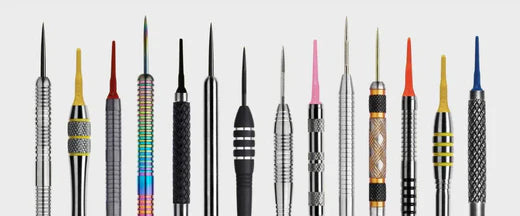
Lukas has been a darts fan since day one and a passionate darts player for over 10 years. After attending the 2016 Darts World Championship at the venerable Alexandra Palace with his future co-founder and then-flatmate Timm, it became clear to him: darts needed to become bigger and more popular in Germany, too. With myDartpfeil and the world's only dart configurator, every darts player—from beginner to professional—can create and customize their own perfect darts.
The dart barrel is the most important element in the construction of every soft and steel dart. Of course, the flight , shaft , and tip also play a significant role, but dart barrels and their weight have the greatest impact on the trajectory of the darts .
Every player has their own throwing style , and no two are comparable. This begins with the grip and continues throughout the entire throwing motion.
For this very reason, we'll explain the different shapes and grip types of dart barrels in more detail in this article. This will help you find out which dart barrel is best suited to you and your throwing style.
The heart of a dart
As already mentioned, the barrel is the handle of the dart and thus generally the most important component of both steel and soft tip darts . There are countless ways to throw darts , and depending on your grip and throwing style, dart barrels should have different properties to create an optimal trajectory.
Dart barrels are generally manufactured in different weights, shapes, lengths , and finishes , and are decorated with a variety of design elements. Soft tip dart barrels are typically manufactured with weights between 14 and 18 grams , while steel tip dart barrels can weigh up to 50 grams.
Steel darts may be a maximum of 30.5 centimeters , while soft darts are significantly shorter at a maximum of 16.8 centimeters due to their lower weight.
The shapes and surfaces, however, are often very different and not immediately obvious, especially for beginners. There's a wide range of variations, which we'll now explain in more detail.
The surfaces are mainly characterized by grooves, pimples and ribbing and are thus reflected in the grip of the dart.

Types of grip on dart barrels – grooves, knobs, ribbing
The grip determines how firmly the dart barrel sticks to your fingers. There are different grip levels available. Tastes can vary considerably.
Some professionals use a completely smooth dart to avoid getting caught on the grip. Other players, however, use a dart with a larger grip because their fingers tend to get damp or sweaty.

Again, no blanket recommendation can be made here. Only by trying out the grip on the board will you find out which type of grip best suits your casting style.
One thing is clear, though: If the dart barrel is smooth, it's extremely important to have a fluid throwing motion , as the lack of grip makes the dart extremely susceptible to minor disruptions in rhythm.
However, if your throwing style is rather slow, dart barrels with a higher grip level make more sense . This at least somewhat prevents slippage and increases throwing precision.
The most important factors when choosing a grip, however, are the position of your fingers and the moment of release . Only then will you determine whether it's a good idea for your finger to practically stick to the dart until release.
The dart barrel grip and its grip are defined by the surfaces with their various characteristics. These can include grooves, dense steel studs , a specific pattern milled into the barrel , or even rubber rings to ensure a good grip.
Below we explain the different grip levels and show you an example of dart barrels from our steel dart and soft dart range.
Grip Level 1 – low grip
The first level of grip offers the least grip on the barrel. This refers to a barrel that is mostly smooth or has only a few details designed to provide a special grip.
These areas with little grip are primarily so-called knurled zones, which resemble pimples, or isolated ringed zones, which are defined by rings . This grip level is primarily suitable for players who easily get stuck on dart barrels and therefore require little grip when throwing darts.
Grip level 2 – medium grip
In the second grip level, however, more grooves are milled in, so that we have longer and stronger knurled and ringed zones.
These grooves make it easier for the player to always grip the dart in the same spot , thus achieving the most consistent throw. However, the risk of slipping remains due to the limited number of grooves.
Grip Level 3 – strong grip
At higher grip levels, the milled nubs or grooves become more pronounced and, above all, denser. There are also different variations.
The ringed zones are now significantly denser, resulting in multiple rings at shorter intervals – multi-ringed zones – which greatly improves the grip of the rings. Furthermore, so-called shark and razor zones can be identified .
The edges of the grooves are much sharper , creating a strong grip.
Tip: It's important to note that grip isn't good for every player. Some players have become accustomed to a smooth barrel, so a barrel with a high grip level is more of a hindrance, as the dart tends to "catch" on their finger during release.
Grip level 4 – very strong grip
The highest level of grip is characterized by the highest level of grip. The barrel surface usually consists only of grip zones , predominantly using the Shark or Razor Grip.
Some dart barrels now even feature an Ultra Shark Grip , which ensures the ultimate grip on the barrel. This grip is so strong that many players complain that it causes them serious problems when releasing the dart.
But especially for players with very wet and sweaty hands, the Ultra Shark Grip offers a very good option.

Some players even use rubber rings, which they integrate into the grooves or rings, to gain the necessary grip on the rubber. This allows them to grip the barrel solely through the rubber rings . However, this technique is highly individual and therefore recommended only for experienced professionals.
Barrel shapes – Different focuses on the dart barrel
The barrel shape is shrouded in legend. Many swear by a specific shape, but the devil is in the details. Overall, there are three most common barrel shapes , although there are also other exotic shapes.
In the following paragraphs we will take a closer look at the three most common shapes and show you an example of a barrel from our steel dart and soft dart range.

The drop shape
The teardrop shape has been around for a while and is popular with many players. The shape of the dart barrel resembles—surprise surprise—a teardrop. The barrel becomes significantly wider toward the tip .
This shifts the center of gravity forward. Players who prefer to grip the darts from the front often opt for the teardrop shape.
The reason for this is that the center of gravity is far forward and the dart therefore maintains a stable curve in flight if you grip the dart further forward.
The situation is different if the player touches the barrel at the very back. This is precisely why the grip on the dart, in combination with the shape of the dart barrel, is so extremely important.
Simon Whitlock is one of the most famous players who played with this type of barrel shape, especially at the beginning of his career. The typical grip at the very front of the dart inspired him to have his own darts made in a teardrop shape – with great success for a long time.
Meanwhile, Whitlock also plays a dart with a hollow in the barrel so that he can always touch the dart in the same place.
The cylindrical shape
In these cases, as with Simon Whitlock after his switch, the cylindrical shape is more likely to be used. The cylindrical shape actually only indicates that the barrel is approximately the same thickness throughout .
This means there are no differences in the shape of the dart barrel, as with a teardrop-shaped barrel, for example. The cylindrical shape is particularly advantageous for players who grip the barrel further back .
Due to the even distribution of the weight, the arrow can be gripped far back and still guarantees a stable flight curve.

The cylindrical shape probably has the most successful examples on the current PDC circuit. Michael van Gerwern, in particular, who has been playing his darts completely unchanged for what feels like an eternity, swears by this shape.
For Phil Taylor, however, things were different in his heyday. Despite the grip being positioned further back, he used the torpedo shape of his dart barrels for a very long and successful period.
The torpedo shape
The third shape is the torpedo shape, which has enjoyed increasing popularity , especially in recent years. As the name suggests, the torpedo shape resembles the shape of a torpedo.
In terms of the dart barrel, this means that the barrel is thickest in the middle and thinner toward the two ends . Thus, the center of gravity of this model is exactly in the middle of the barrel.
It must be said that this is actually a rather unusual shape for darts, as only a few players grip the barrel exactly in the middle.
The center of gravity in particular often causes problems when throwing the dart , but in recent years more and more dart players have been playing successfully with this form of dart barrel.
Ready to upgrade your darts game? Discover everything you need to know about the best dart equipment and how it can boost your accuracy:
- Changing and sharpening dart tips : Learn what's important and what you absolutely need to pay attention to here. Click here now!
- The agony of choice: Dartboard made of cork or sisal ? An expert explains the pros and cons. Click here to find out more.
- 2-hole or 3-hole dartboard ? All the pros and cons at a glance! The most important information in a nutshell. We'll help you make the right decision!
Sofern nicht anders angegeben, unterliegt das im Beitrag gezeigte Bildmaterial mit Bezug zu Dartspielern und verwandten Themen dem Copyright der Professional Darts Corporation (© PDC).

